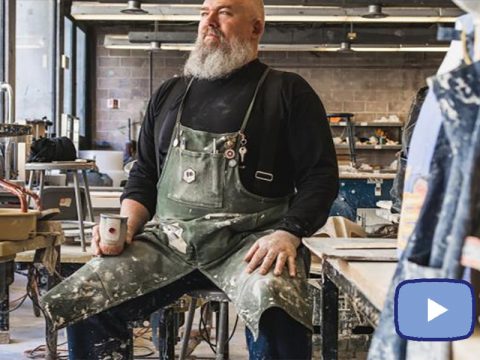
By Charlie Schmidlin
The basics of capoeira can be taught in a book, studied on YouTube, or verbally explained, but it isn’t until one participates in a roda (pronounced “hoda”) – an extended showcase encased within a circle of players – that the Afro-Brazilian martial art is truly revealed.
As much a celebration as training ground, the roda allows students and teachers from different areas to spar – two at a time – and also to joke with one another. Yes, the rhythm-based martial art contains room for fun, and over the course of a month, I discovered this fact at Art Share LA – a non-profit warehouse housing artist exhibitions, classes and events across 28,000 sq. ft. – where Capoeira Brasil DTLA finds its main venue.
The team leading the operation, Saracuru and Pantera – their capoeira monikers, essential to the art – are a young, married couple who met through mutual friends in 2010. “Sara” grew up in Paris, and started learning capoeira at a young age: first from his uncle, who taught him movements in the backyard, and then during P.E. at school. His passion led him to traveling to Brazil over summers for further training, and finally he began teaching his own classes, first in Paris, and then overseas.
Pantera, a West-Central LA native, met Sara in 2010, when he was spending time back and forth between Paris and the United States teaching workshops, before he finally decided to move to LA. “We ended up hitting it off,” she says, “And throughout that time I took up a love for capoeira, because that’s what my love loves.” She is now in her third year of learning the art.
The pair set up shop originally in the Alexandria Hotel, but not long after relocated to Art Share LA, for their weekday classes, as well as Tapout LA, where they teach an intense Saturday session. And although its teachings can work effectively as martial arts maneuvers, capoeira is also a dance, and one that has a very specific reason for existing as such.
It finds its origins in colonial Brazil, amongst African slaves working on sugarcane farms. As a means of basic survival against their colonist owners, they disguised their techniques in a game: defensive evasions, called esquivas, alongside a volley of leg sweeps and kicks. Sara says, “Capoeira is a martial art of course, but it’s music also, it’s culture, it’s a community. It’s a ‘dance camouflage.’ ”
In every class, along with around five to ten other individuals of varying skill levels, I warm up and stretch to a continual beat played by Sara. On some occasions he uses the atabaque (hand drum); on others he plays the berimbau, a long stringed instrument that sets the tempo to many activities.
Afterwards, we shift into learning new basics: at the very root of capoeira is a side-to-side movement, called a ginga, that moves your feet in a triangular step in order to transition into other positions. Then comes the esquiva, much easier in that is essentially ducking down to evade a kick or blow, and the Meia Lua de Frente, a half-moon kick drawing across the face of your opponent.
The combinations are plentiful, as I attempt to differentiate between a Chapa de Costas and Chapa de Frente kick, but once I link the Portuguese names to my physical movements, the connections start to form. Sara and Pantera keep the classes moving fluidly as we train, stopping only for water breaks and clarification on a technique. I’m given the capoeira nickname, “Jornalista,” and we continue.
The few weeks of instruction leads to my first roda, which brings close to twenty participants into the Art Share LA studio. The session lasts for two hours, which flies by as veterans and newcomers jump into the center surrounded by singing, clapping players waiting their turn. I last seven rotations before fatigue and an unfortunate blister lowers my involvement down to a half-hearted shimmy; however, I still enjoy watching others break new ground in their training.
As capoeira students advance in skill, they obtain belts in a system different to the usual martial arts progression. Sara explains, “When you start, you start with a corda crua (“raw cord” in Portuguese) – it’s not white, but more simply without color. Usually they use a white belt in capoeira for the grandmaster, one with over fifty years of experience.” Ranging from crua-yellow to blue – a “monitor,” between a student and teacher – the student can then become a “graduated student,” and spread their knowledge to others from there.
Moving forward, Capoeira DTLA is hoping to expand to more audiences, and namely, a younger one. Sara’s next goal is “to start a kids class, and a free community class in the summer, in July or August,” with Pantera helping to organize it. They envision using one of the growing number of parks in DTLA as a venue – a wise choice that stands to increase capoeira’s visibility for those unaware or nervous about it.
“I had a friend, unfortunately passed away now, who said about capoeira, ‘Everyone can read it, but not everyone can understand it,’ ” Sara recounts. “It’s like chess – it’s challenging, but once you start to understand what you’re doing, it raises your mood. If I have a hard day at my job, I come, I practice a little capoeira, and I feel much better. That’s my goal: to pass rhythm, and my techniques, that feeling on to anyone who trains here.”
Capoeira Brasil DTLA runs Mondays and Wednesdays at Art Share LA (801 E 4th Pl, Los Angeles, CA 90013), and Saturdays at Tapout LA (400 W Pico Blvd, Los Angeles, CA). Find out more about the group at Facebook.com/CapoeiraBrasilDowntownLA.
.
Share LA (801 E 4th Pl, Los Angeles, CA 90013), and Saturdays at Tapout LA (400 W Pico Blvd, Los Angeles, CA). Find out more about the group at Facebook.com/CapoeiraBrasilDowntownLA.











